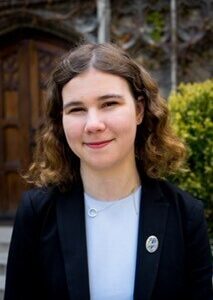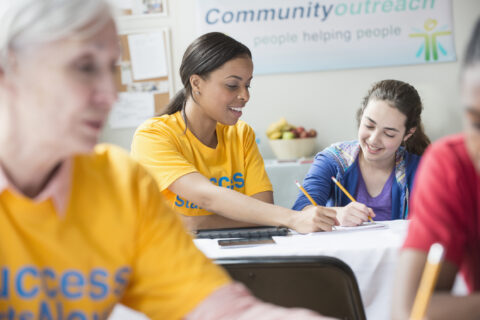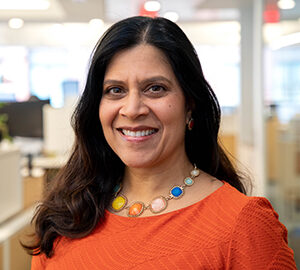Afterschool and summer learning programs are proven strategies to support young people’s growth and development. However, over 24.7 million youth remain unable to enroll in programs across the country. To understand what keeps older youth (ages 14-19) from accessing afterschool and summer learning programs, The Wallace Foundation commissioned a youth-led research project, “Youth Perspectives on Designing Equitable Out-of-School-Time Programs,” and accompanyingBeyond the Classroom Podcast. Based on the research findings, NLC has identified 5 important lessons for cities working to make afterschool and summer learning programs accessible for older youth:
#1: Support Basic Needs
A young person whose stomach is grumbling can’t be expected to fully participate in their afterschool program. Cities are well-positioned to support the basic needs of young people so that they can focus on excelling in their programs. To address hunger, cities can offer meals at city-run program sites or provide financial support for programs to do so. To ensure access to reliable transportation, cities can partner with program providers and schools to offer subsidized transportation for youth along popular routes. For example, the City of Sacramento, CA has created RydeFreeRT, which provides free public transit rides for youth in grades K-12 so they can easily access afterschool programs. Reducing afterschool program fees for city-run programs or providing funding for youth to access programs run by community-based organizations, can also ease the burden on families struggling to make ends meet. For example, the City of Missoula, MT used American Rescue Plan Act funds to support a sliding-fee scale for city-run afterschool programs. The Building, Sustaining, Improvingfunding guide, created by EducationCounsel with support from The Wallace Foundation, offers further guidance on funds cities can leverage to support youths’ basic needs after school.
#2: Compensate Youth for Their Time
The pandemic and inflation have exacerbated the need for many older youths to support their families financially. The necessity of earning a wage was identified as a top barrier preventing youth from participating in programs. Offering a stipend to older youth enrolled in programs can prevent them from having to choose between providing for their families and participating in an enriching and developmentally beneficial learning experience. Cities can offer these stipends themselves, or advocate for compensation at the programs in their communities. For example, the City of Seattle, WA’s Seattle Youth Employment Program offers participation stipends to low-income youth ages 16-24 who receive job skills training and internship placement through the program.
#3: Uplift and Incorporate Youth Voice into Practice
Young people vote with their feet. If programs or services don’t align with their interests or needs, young people won’t feel included and will often stop attending. Cities can act as a model – uplifting the voices of existing youth advisory groups, such as youth councils, and incorporating their perspectives into city practices and policies. Cities can then use the power of the bully pulpit and the advocacy efforts of their youth advisory groups to encourage providers to do the same. In doing so, cities can place an emphasis on ensuring that the youth whose voices are uplifted accurately represent the city’s diversity. The City of Dublin, GA promotes youth voice through its youth council, which attends city commissioner meetings and gives presentations to the local school board.
#4: Foster Inclusive Spaces for Youth of All Backgrounds
Researchers found that 45% of youth felt they were treated differently in their afterschool or summer program because of their identity. Making afterschool and summer learning programs accessible to youth isn’t just about physical access, it’s also about ensuring youth feel valued and accepted in programs. Cities can work with program providers to create inclusive spaces for all youth by offering professional development for staff or supporting the implementation of diverse hiring practices to expose youth to a diversity of perspectives. Utilizing strengths-based language is another way to foster a “sense of dignity and belonging” among youth. Instead of referring to youth as “at-risk” and in need of “fixing” by programs, cities can emphasize youths’ assets and demonstrate their respect for youths’ perspectives. In doing so, cities can act as a model for programs to adopt similar language and mentalities regarding the youth they serve.
#5: Eliminate the Information Gap
The youth researchers found that many young people were unaware of the programs in their communities or that many of these programs offered financial aid. The passage of information by word-of-mouth, the youth noted, limits knowledge of opportunities to specific social groups – creating an information gap. This gap is exacerbated by adults and peers “gatekeeping” information from certain youth. To eliminate this gap, cities can make information about programs widely available by sharing program information at public sites and city-wide events, especially those identified by youth as popular. The City of Houston’s Out2Learn initiative has a digital map of programs across the city, making the information easily accessible to youth throughout Houston.
While this list is not exhaustive, it provides a snapshot of some of the many barriers young people face in accessing afterschool and summer learning programs. As cities work to make programs more accessible, it is important to engage local stakeholders to better understand the unique hurdles to participation present in each community.
For help expanding access to afterschool and summer learning programs in your city, contact NLC’s Education & Expanded Learning team at educationexpandedlearning@nlc.org.







